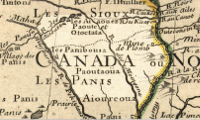The Making of the 50 States: Iowa
Part 1: In the Beginning People lived in what is now Iowa for a long time before Europeans arrived. One of the early Native American cultures was the Woodland culture. Iowa's past also includes the Effigy Mound Builders, of which remains the Effigy Mounds National Monument. As with many other surrounding states, Iowa got a visit from the French explorer René-Robert Cavelier Sieur de La Salle in 1682. He, of course, claimed the land for his king, Louis XIV of France. Nine years earlier, two other famous Frenchmen, Father Jacques Marquette and Louis Jolliet, had come through, canoeing down the Wisconsin and then the Mississippi River. 
Among the Native American tribes who have lived in the area are the Chippewa, Dakota Sioux, Fox, Illinois, Iowa, Meskwaki, Missouria, Moingwena, Nez Perce, Omaha, Otoe, Ottawa, Pahodja, Peoria, Ponca, Potawatomi, Sauk, and Winnebago. In many cases, they lived a traditional life on the plains, growing crops like beans and corns and hunting buffalo. French settlements in the area grew steadily after the actions of French-Canadian Julien Dubuque, who in 1788 bought land from one of the Native American tribes to mine lead. The area was part of the lands that France handed over to Spain at the end of the French and Indian War. The Louisiana Purchase brought the Louisiana Territory into the American fold. The Corps of Discovery led by Meriwether Lewis and William Clark set out to discover the new lands and passed through the Iowa area in 1804. Sergeant Charles Floyd, died in Iowa, near what is now Sioux City; he was the only known soldier to die on the expedition. The explorer Zebulon Pike, who would later have a tall mountain peak named after him in the Rocky Mountains, explored the Mississippi River above St. Louis in the early 1800s. The United States Army built Fort Madison in 1808. It was the target of two sieges during the War of 1812, with U.S. Army troops burning the fort in 1813 to keep it from falling into British hands. Next page > The Rest of the Story > Page 1, 2
|
|
Social Studies for Kids
copyright 2002–2024
David White




